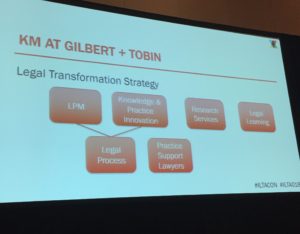This is a live blog post from ILTACon, the 2016 conference of the International Legal Technology Association. This session is the Future of Legal KM with panelists Rob Saccone (Partner Nexlaw Partners LLC), Patrick DiDomenico (CKO, Ogletree Deakins), and Sam Nickless (COO, Gilbert & Tobin). Steve Lastres, Director of Library & Knowledge Management, of Debevoise moderates. The session description appears at the end of this post. I wrote this post while the session took place and published as it ended. So please forgive any typos or mistakes of understanding.
What is the Current State of KM? – Patrick DiDomenico
“The future is now – some of the future is already here.”
Ogletree KM is about improving the business and practice of the firm. That should be the goal of all support functions in a law firm. If you do not move the business forward, you hurt the firm. At Ogletree, KM tries to improve the knowledge sharing culture. The firm is open and pre-disposed to sharing, which is a big benefit to enable KM. So the KM team builds on that culture with access to information such as Intranets. This may be obvious but it’s important to keep sight of the bigger picture and goal.
The firm broadcasts the message to clients. The firm’s client pledge includes using technology and KM to better serve clients.
What is Driving Change in KM? Rob Saccone
All firms have felt pressure post 2010 recession. The buyer-seller dynamic for legal services has changed significantly. There is more competition and choices for clients,, who face much pressure to reduce costs. That cost pressure has flowed through to law firms.
The market has changed permanently. These changes affect KM – it’s an ingredient to help law firms do more with less. But the KM is fragmented across firms. Over the last couple of years, I’ve seen KM function inherit more functions from elsewhere in the firm. For example, LPM, process improvement, and library are often now under KM. Why are these under KM? The reason is that KM leaders are best suited to managed these functions. There is no other good fit in the firm. But reporting lines vary widely by firm.
The traditional KM work has not changed very much. The change is inheriting more functions and being more focused on client service. But the broader scope varies widely. A lot of KM professionals have to make it up as they go.
Sam adds: clients want to see KM in more detail, how it works, and who is running it. Specific client needs drive KM.
Patrick adds: Tom Baldwin once said that the financial collapse of 2008 was the best thing that ever happened to legal KM. The combination of economics and client demand has driven KM demand and capabilities.
Rob asks if KM now is different post vs. pre-recession…. Patrick says the scope has broadened. We also see a renewed interest in people. Ogletree has grown from 1 PSL to 4. Firms now recognize the need for more support and lawyers to focus on content development.
But less than one third of hands go up in room responding to how many have seen KM become more client focused at their firms.
Patrick: Ogletree has seen double digit increases in the number of RFPs, even from existing clients. This leads to more collaboration between marketing (client services) and KM. It’s important now to answer RFP questions in more than a “check the box” manner. The same changes are driving more firms to develop products such as technology services or packaged AFA arrangements.
Oz Benamram asks if RFPs involve clients or procurement? Answer: both. Changes in outside counsel guidelines and more RFPs suggest that clients – whether GC or procurement – are more serious about how they select law firms.
Steve: “It takes a village to complete RFPs” Marketing, IT, KM, lawyers, and others. Having a workflow to respond is key.
The Role of the KM Professional – Sam Nickless
Sam brings the COO perspective, with KM just one of many functions reporting to him. For me, KM professionals are the ultimate utility players. They can fill gaps. As new opportunities and tech arrive, gaps open up, and KM folks are the ones best at filling the gap.
I think of the term “designer” when I think of KM. With emphasis on design thinking now applying to customer experience (and not just products), I see KM professionals playing that role. For example, if we have new tech helping how we deliver due diligence in M&A, there are numerous steps in change management that our KM team leads.
I agree that KM professionals are now more externally focused. Lawyers tend to divide the world into two: lawyers and non-lawyers. I see evidence that this artificial divide is disappearing. KM professionals help erase the line with their client interactions.
KM will move from behind the scenes to an important part of strategy and sales process.
The current G&T org structure:
At Ogletree, the KM department has expanded to 25 people broken into several departments as illustrated in the org chart below. LPM also reports to KM. Examples of other changes include new roles such as dedicated PM in KM.
Rob discusses, with permission, KM at Seyfarth. Over time, the KM team became more and more engaged on client projects. Initially, partners were somewhat resistant but eventually they embraced. Ultimately, a subset of KM team became focused on client facing KM functions. Some stayed in internal fucntions but the external part included business analysts, user experience specialists, and legal project managers. Client facing work ultimately led to Seyfarth spinning up a consulting arm to help law departments with how they operate. But Seyfarth focus on external KM slowed down development of internal KM. That fixed itself as client demanded certain services. There is still no formal internal KM function but the infrastructure is evolving now with the client pressure.
Sam … All the additional roles I mentioned made our firm think about how do we best meet internal needs. It may mean we need more resources – but that raises economic issues. The rise of external KM does not make the need for internal KM to diminish.
From audience re uncommon KM roles:
- BD team looking for ways to manage RFPs, lit attorneys looking for contract management system to analyze contract language. We are seeing biz analysts in IT liaise directly with lawyers to address these issues.
What is the Impact of Technology on KM – Patrick
The biggest impact is the consumerization of technology. User experience has become a key theme. I breakdown tech into two groups: core infrastructure versus the user interface and user experience side. There has long been a disconnect between the two.
The iPhone ushered in an era of design-centered thinking and emphasis on user experience. This has led to lawyers demanding that internal tech deliver the same kind of easy experience of mobile apps. This is hard – it takes a lot of time and money. But it drives usages.
Sam adds that in past tech often entailed huge decisions / projects such as changing document management. But now, with cloud and software as a service (rent for what you need) has made it MUCH easier to try new tools and change. New skills required though to take advantage of this.
Rob … Don’t focus on the tech, focus on what is the problem to be solved. Then look at the process to solve it. Then look at the tech to support that process. KM should play the role of figuring out the problem and figuring out the process, then it can drive the right selection of tech.
Audience question: Former lawyer, 2.5 years doing KM. Two members of IT shifted to my KM team. Big challenge was UI / UX. Developers focused too much on functionality, not presentation lawyer. Having developers is key but it’s taken 18 months to align on what success means: good design of ease of use.
About half of audience raising hand for having KM department have developers dedicated to KM. For some, it’s a recent development.
What is the Future of KM?
Sam: The concept of product management is key. KM people will act like product managers do in other businesses. There will be product P&Ls. They will manage a business. Technology will be key – as will be large volumes of data. We are still trying to figure out how to turn all of our data into insights to help our clients and our lawyers.
Patrick: It will get better for KM professionals. The default mode among lawyers is shifting from keep it close to share it. This is driven, in part, by rise of social media. Lawyers will look to tech to help with sharing.
Rob: Hard to add. We will see more divergence among / within KM professionals into more specialized functions. Read a book on Lean Start-up – take inspiration for how to develop product quickly.
————————
Session Description
Knowledge management (KM) in law firms has been a key component to the successful delivery of client services. Thanks to recent advances in better analytics, less expensive start-up costs and a focus on empowering the next generation of workforce, KM of the future is shining bright. As law firms move quickly to address new client-first imperatives, they are leveraging knowledge management to support smarter answers, improved decisions and better outcomes. What does the future hold for legal KM? Come find out what’s next!
Archives
Blog Categories
- Alternative Legal Provider (44)
- Artificial Intelligence (AI) (57)
- Bar Regulation (13)
- Best Practices (39)
- Big Data and Data Science (14)
- Blockchain (10)
- Bloomberg Biz of Law Summit – Live (6)
- Business Intelligence (21)
- Contract Management (21)
- Cool Legal Conferences (13)
- COVID-19 (11)
- Design (5)
- Do Less Law (40)
- eDiscovery and Litigation Support (165)
- Experience Management (12)
- Extranets (11)
- General (194)
- Innovation and Change Management (188)
- Interesting Technology (105)
- Knowledge Management (229)
- Law Department Management (20)
- Law Departments / Client Service (120)
- Law Factory v. Bet the Farm (30)
- Law Firm Service Delivery (128)
- Law Firm Staffing (27)
- Law Libraries (6)
- Legal market survey featured (6)
- Legal Process Improvement (27)
- Legal Project Management (26)
- Legal Secretaries – Their Future (17)
- Legal Tech Start-Ups (18)
- Litigation Finance (5)
- Low Cost Law Firm Centers (22)
- Management and Technology (179)
- Notices re this Blog (10)
- Online Legal Services (64)
- Outsourcing (141)
- Personal Productivity (40)
- Roundup (58)
- Structure of Legal Business (2)
- Supplier News (13)
- Visual Intelligence (14)


